Change Management Analysis: Unilever's Shift to Divisional Structure
VerifiedAdded on 2021/02/21
|12
|3504
|1634
Report
AI Summary
This report provides a comprehensive analysis of change management strategies implemented by Unilever, focusing on its transition from a hierarchical to a divisional organizational structure. It explores the reasons behind this transformational change, emphasizing the company's need for product innovation and market adaptability. The report delves into the application of Kurt Lewin's and John Kotter's change models, illustrating how Unilever utilized these frameworks to manage the transition effectively. It examines the driving forces behind the change, both positive and negative, and identifies potential resistance from employees. Furthermore, the report highlights the role of leadership in facilitating the change process, emphasizing the importance of communication, vision, and overcoming obstacles to ensure a successful organizational transformation. The report concludes by evaluating the positive outcomes of the change on Unilever's overall performance and innovation capabilities.
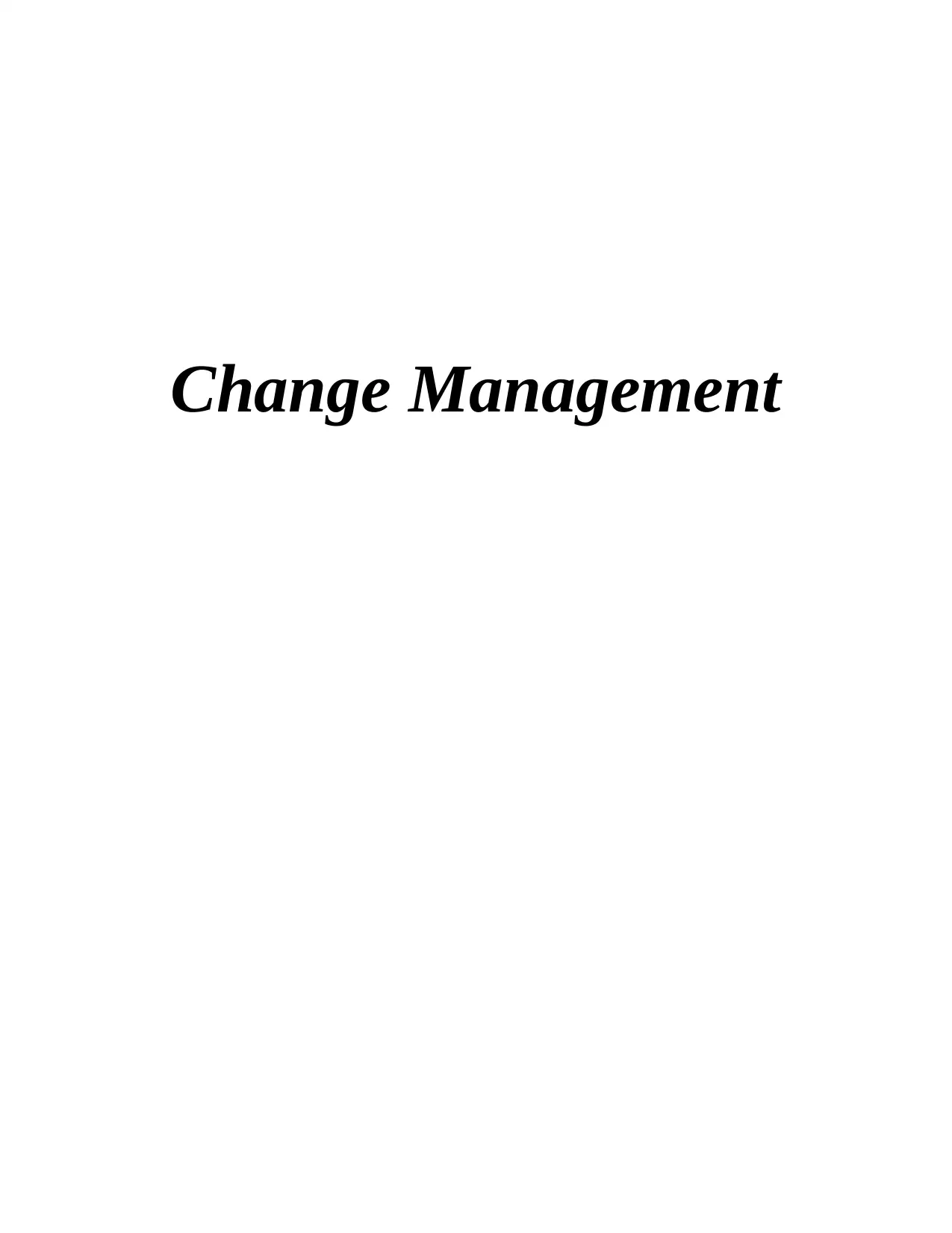
Change Management
Paraphrase This Document
Need a fresh take? Get an instant paraphrase of this document with our AI Paraphraser
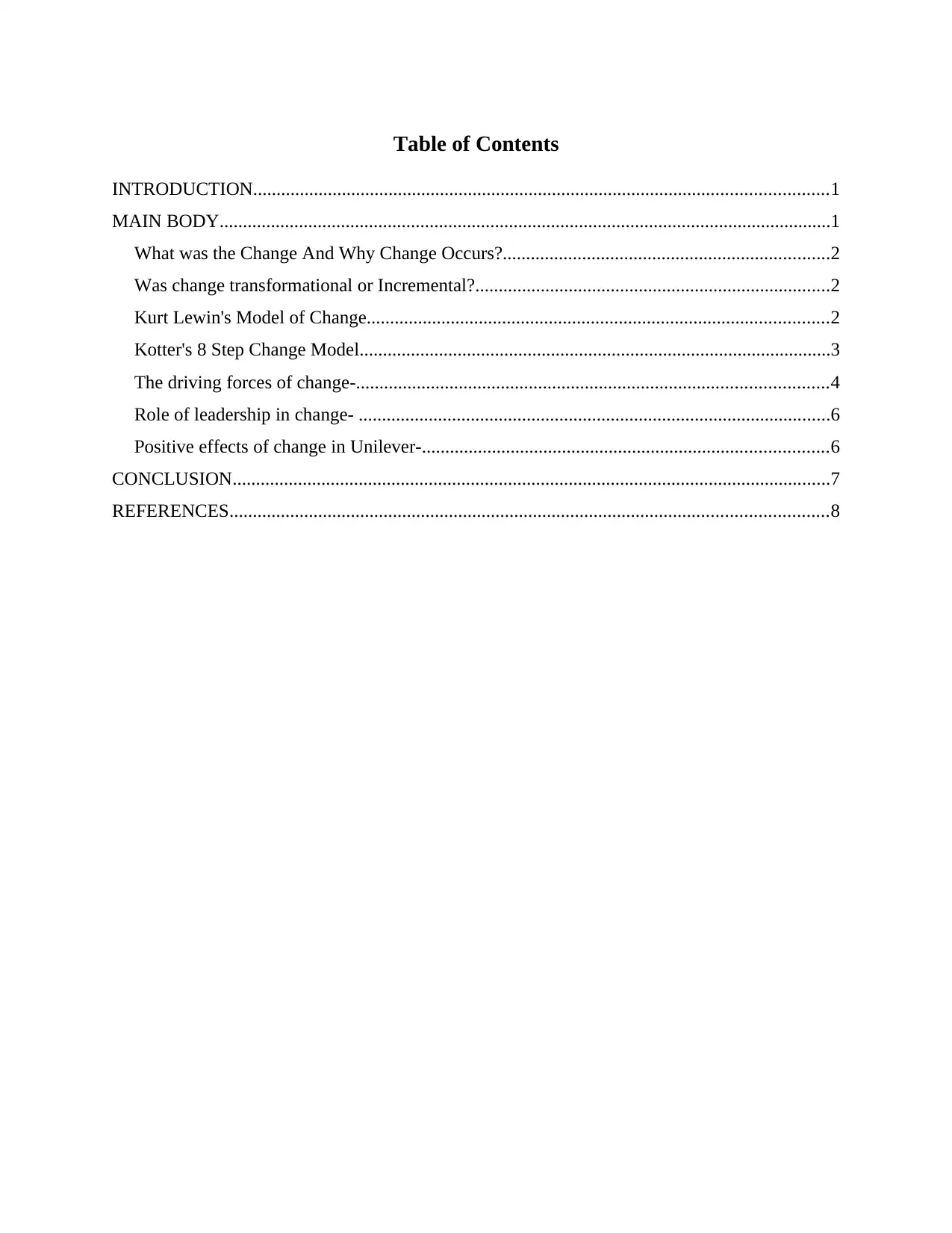
Table of Contents
INTRODUCTION...........................................................................................................................1
MAIN BODY...................................................................................................................................1
What was the Change And Why Change Occurs?......................................................................2
Was change transformational or Incremental?............................................................................2
Kurt Lewin's Model of Change...................................................................................................2
Kotter's 8 Step Change Model.....................................................................................................3
The driving forces of change-.....................................................................................................4
Role of leadership in change- .....................................................................................................6
Positive effects of change in Unilever-.......................................................................................6
CONCLUSION................................................................................................................................7
REFERENCES................................................................................................................................8
INTRODUCTION...........................................................................................................................1
MAIN BODY...................................................................................................................................1
What was the Change And Why Change Occurs?......................................................................2
Was change transformational or Incremental?............................................................................2
Kurt Lewin's Model of Change...................................................................................................2
Kotter's 8 Step Change Model.....................................................................................................3
The driving forces of change-.....................................................................................................4
Role of leadership in change- .....................................................................................................6
Positive effects of change in Unilever-.......................................................................................6
CONCLUSION................................................................................................................................7
REFERENCES................................................................................................................................8
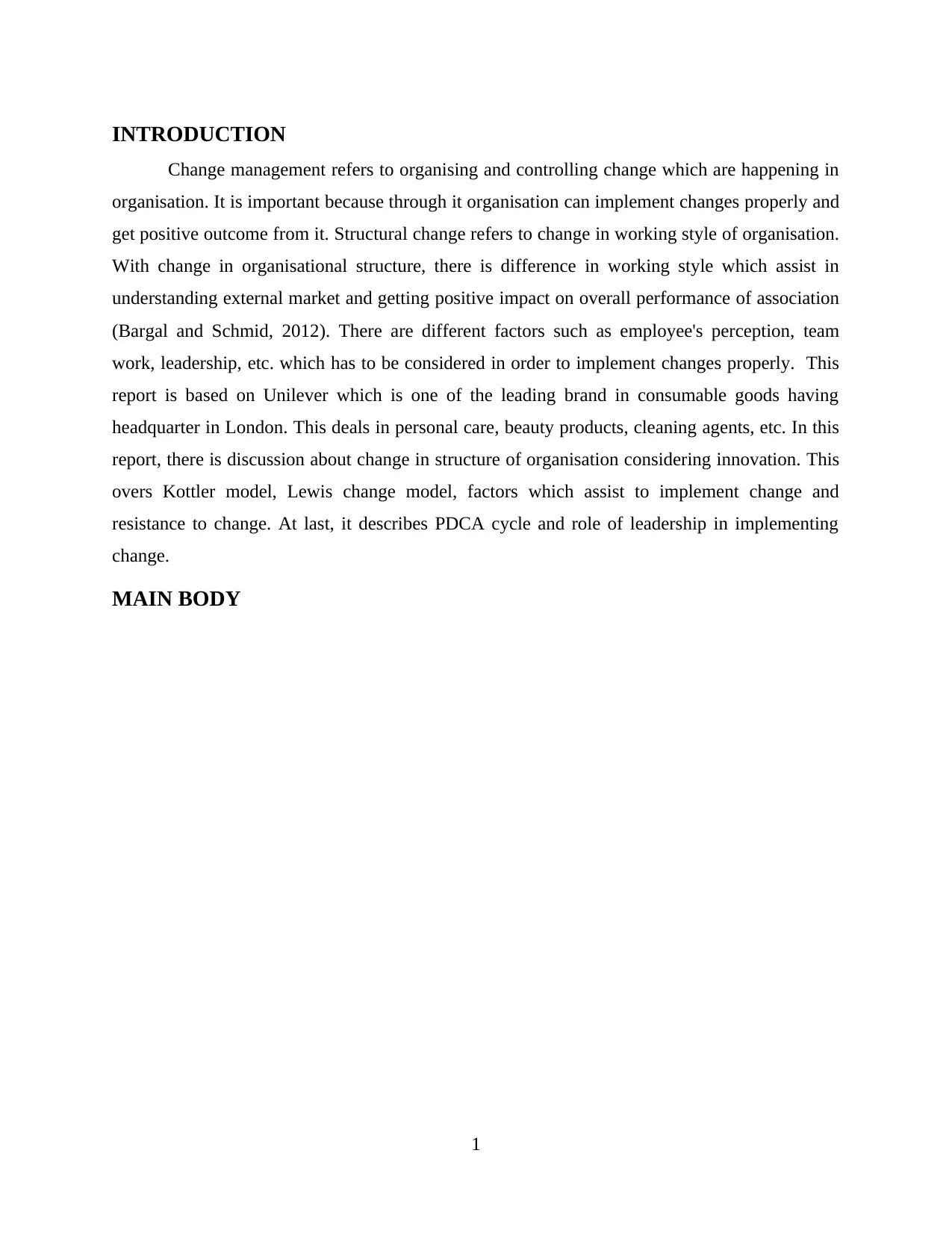
INTRODUCTION
Change management refers to organising and controlling change which are happening in
organisation. It is important because through it organisation can implement changes properly and
get positive outcome from it. Structural change refers to change in working style of organisation.
With change in organisational structure, there is difference in working style which assist in
understanding external market and getting positive impact on overall performance of association
(Bargal and Schmid, 2012). There are different factors such as employee's perception, team
work, leadership, etc. which has to be considered in order to implement changes properly. This
report is based on Unilever which is one of the leading brand in consumable goods having
headquarter in London. This deals in personal care, beauty products, cleaning agents, etc. In this
report, there is discussion about change in structure of organisation considering innovation. This
overs Kottler model, Lewis change model, factors which assist to implement change and
resistance to change. At last, it describes PDCA cycle and role of leadership in implementing
change.
MAIN BODY
1
Change management refers to organising and controlling change which are happening in
organisation. It is important because through it organisation can implement changes properly and
get positive outcome from it. Structural change refers to change in working style of organisation.
With change in organisational structure, there is difference in working style which assist in
understanding external market and getting positive impact on overall performance of association
(Bargal and Schmid, 2012). There are different factors such as employee's perception, team
work, leadership, etc. which has to be considered in order to implement changes properly. This
report is based on Unilever which is one of the leading brand in consumable goods having
headquarter in London. This deals in personal care, beauty products, cleaning agents, etc. In this
report, there is discussion about change in structure of organisation considering innovation. This
overs Kottler model, Lewis change model, factors which assist to implement change and
resistance to change. At last, it describes PDCA cycle and role of leadership in implementing
change.
MAIN BODY
1
⊘ This is a preview!⊘
Do you want full access?
Subscribe today to unlock all pages.

Trusted by 1+ million students worldwide
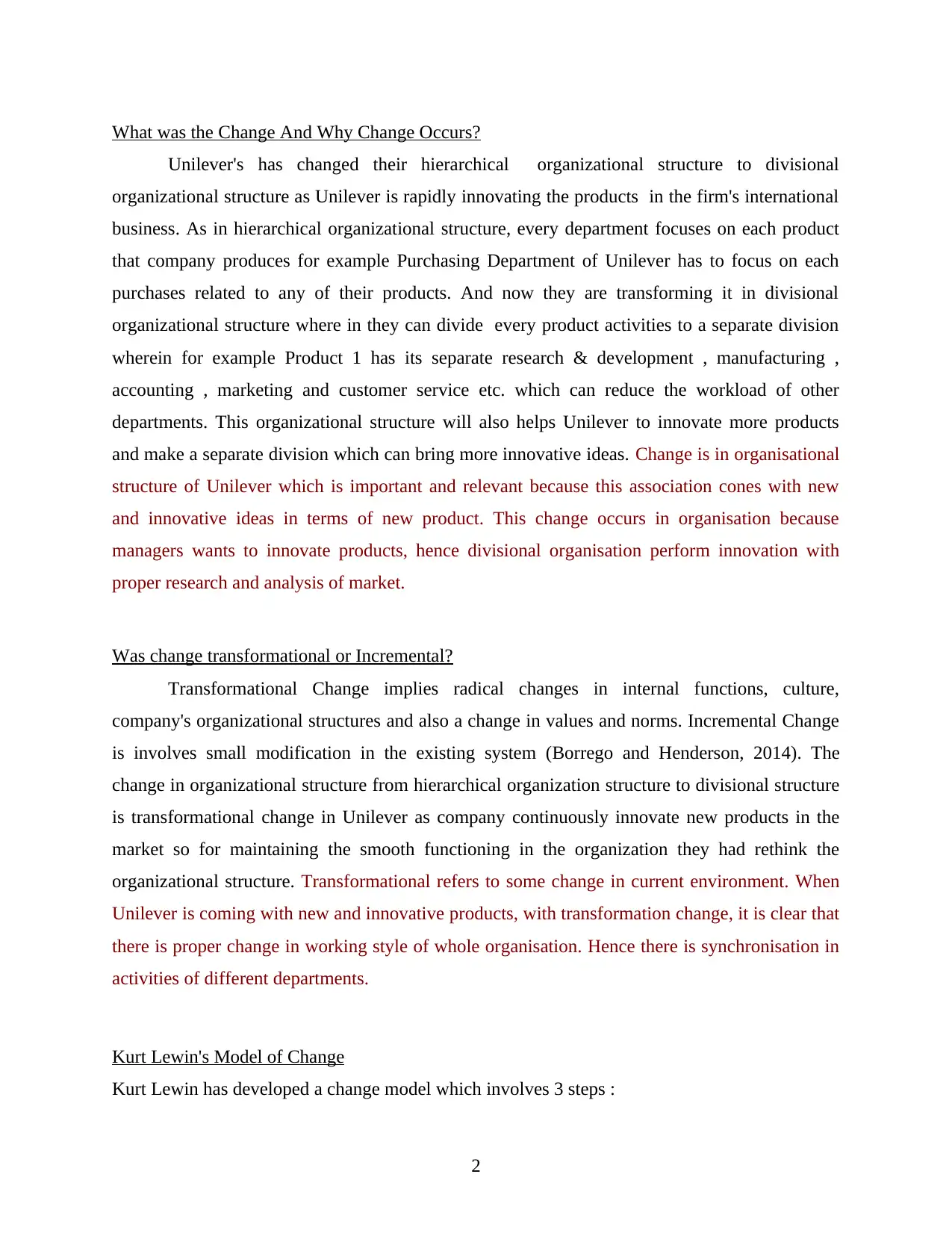
What was the Change And Why Change Occurs?
Unilever's has changed their hierarchical organizational structure to divisional
organizational structure as Unilever is rapidly innovating the products in the firm's international
business. As in hierarchical organizational structure, every department focuses on each product
that company produces for example Purchasing Department of Unilever has to focus on each
purchases related to any of their products. And now they are transforming it in divisional
organizational structure where in they can divide every product activities to a separate division
wherein for example Product 1 has its separate research & development , manufacturing ,
accounting , marketing and customer service etc. which can reduce the workload of other
departments. This organizational structure will also helps Unilever to innovate more products
and make a separate division which can bring more innovative ideas. Change is in organisational
structure of Unilever which is important and relevant because this association cones with new
and innovative ideas in terms of new product. This change occurs in organisation because
managers wants to innovate products, hence divisional organisation perform innovation with
proper research and analysis of market.
Was change transformational or Incremental?
Transformational Change implies radical changes in internal functions, culture,
company's organizational structures and also a change in values and norms. Incremental Change
is involves small modification in the existing system (Borrego and Henderson, 2014). The
change in organizational structure from hierarchical organization structure to divisional structure
is transformational change in Unilever as company continuously innovate new products in the
market so for maintaining the smooth functioning in the organization they had rethink the
organizational structure. Transformational refers to some change in current environment. When
Unilever is coming with new and innovative products, with transformation change, it is clear that
there is proper change in working style of whole organisation. Hence there is synchronisation in
activities of different departments.
Kurt Lewin's Model of Change
Kurt Lewin has developed a change model which involves 3 steps :
2
Unilever's has changed their hierarchical organizational structure to divisional
organizational structure as Unilever is rapidly innovating the products in the firm's international
business. As in hierarchical organizational structure, every department focuses on each product
that company produces for example Purchasing Department of Unilever has to focus on each
purchases related to any of their products. And now they are transforming it in divisional
organizational structure where in they can divide every product activities to a separate division
wherein for example Product 1 has its separate research & development , manufacturing ,
accounting , marketing and customer service etc. which can reduce the workload of other
departments. This organizational structure will also helps Unilever to innovate more products
and make a separate division which can bring more innovative ideas. Change is in organisational
structure of Unilever which is important and relevant because this association cones with new
and innovative ideas in terms of new product. This change occurs in organisation because
managers wants to innovate products, hence divisional organisation perform innovation with
proper research and analysis of market.
Was change transformational or Incremental?
Transformational Change implies radical changes in internal functions, culture,
company's organizational structures and also a change in values and norms. Incremental Change
is involves small modification in the existing system (Borrego and Henderson, 2014). The
change in organizational structure from hierarchical organization structure to divisional structure
is transformational change in Unilever as company continuously innovate new products in the
market so for maintaining the smooth functioning in the organization they had rethink the
organizational structure. Transformational refers to some change in current environment. When
Unilever is coming with new and innovative products, with transformation change, it is clear that
there is proper change in working style of whole organisation. Hence there is synchronisation in
activities of different departments.
Kurt Lewin's Model of Change
Kurt Lewin has developed a change model which involves 3 steps :
2
Paraphrase This Document
Need a fresh take? Get an instant paraphrase of this document with our AI Paraphraser
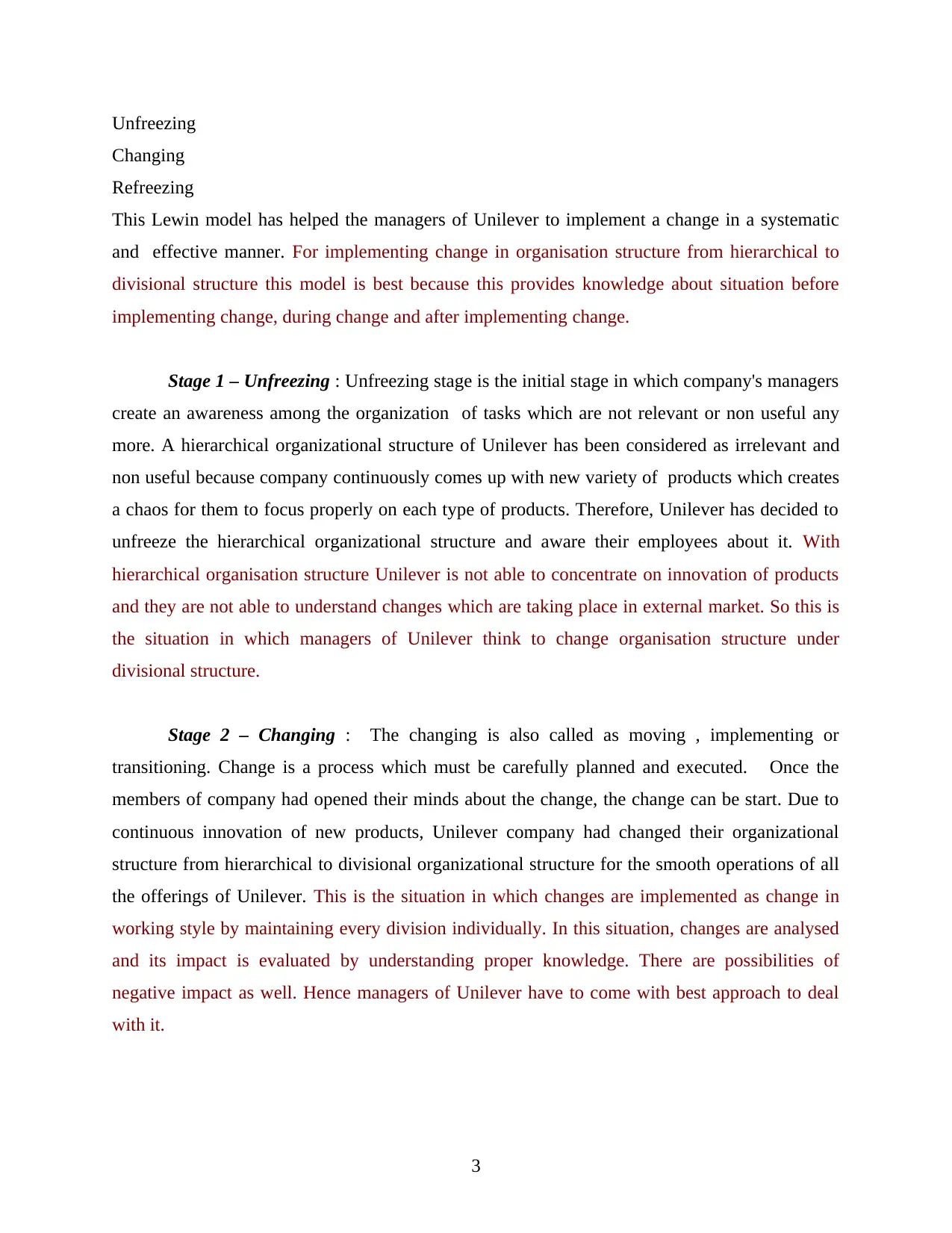
Unfreezing
Changing
Refreezing
This Lewin model has helped the managers of Unilever to implement a change in a systematic
and effective manner. For implementing change in organisation structure from hierarchical to
divisional structure this model is best because this provides knowledge about situation before
implementing change, during change and after implementing change.
Stage 1 – Unfreezing : Unfreezing stage is the initial stage in which company's managers
create an awareness among the organization of tasks which are not relevant or non useful any
more. A hierarchical organizational structure of Unilever has been considered as irrelevant and
non useful because company continuously comes up with new variety of products which creates
a chaos for them to focus properly on each type of products. Therefore, Unilever has decided to
unfreeze the hierarchical organizational structure and aware their employees about it. With
hierarchical organisation structure Unilever is not able to concentrate on innovation of products
and they are not able to understand changes which are taking place in external market. So this is
the situation in which managers of Unilever think to change organisation structure under
divisional structure.
Stage 2 – Changing : The changing is also called as moving , implementing or
transitioning. Change is a process which must be carefully planned and executed. Once the
members of company had opened their minds about the change, the change can be start. Due to
continuous innovation of new products, Unilever company had changed their organizational
structure from hierarchical to divisional organizational structure for the smooth operations of all
the offerings of Unilever. This is the situation in which changes are implemented as change in
working style by maintaining every division individually. In this situation, changes are analysed
and its impact is evaluated by understanding proper knowledge. There are possibilities of
negative impact as well. Hence managers of Unilever have to come with best approach to deal
with it.
3
Changing
Refreezing
This Lewin model has helped the managers of Unilever to implement a change in a systematic
and effective manner. For implementing change in organisation structure from hierarchical to
divisional structure this model is best because this provides knowledge about situation before
implementing change, during change and after implementing change.
Stage 1 – Unfreezing : Unfreezing stage is the initial stage in which company's managers
create an awareness among the organization of tasks which are not relevant or non useful any
more. A hierarchical organizational structure of Unilever has been considered as irrelevant and
non useful because company continuously comes up with new variety of products which creates
a chaos for them to focus properly on each type of products. Therefore, Unilever has decided to
unfreeze the hierarchical organizational structure and aware their employees about it. With
hierarchical organisation structure Unilever is not able to concentrate on innovation of products
and they are not able to understand changes which are taking place in external market. So this is
the situation in which managers of Unilever think to change organisation structure under
divisional structure.
Stage 2 – Changing : The changing is also called as moving , implementing or
transitioning. Change is a process which must be carefully planned and executed. Once the
members of company had opened their minds about the change, the change can be start. Due to
continuous innovation of new products, Unilever company had changed their organizational
structure from hierarchical to divisional organizational structure for the smooth operations of all
the offerings of Unilever. This is the situation in which changes are implemented as change in
working style by maintaining every division individually. In this situation, changes are analysed
and its impact is evaluated by understanding proper knowledge. There are possibilities of
negative impact as well. Hence managers of Unilever have to come with best approach to deal
with it.
3
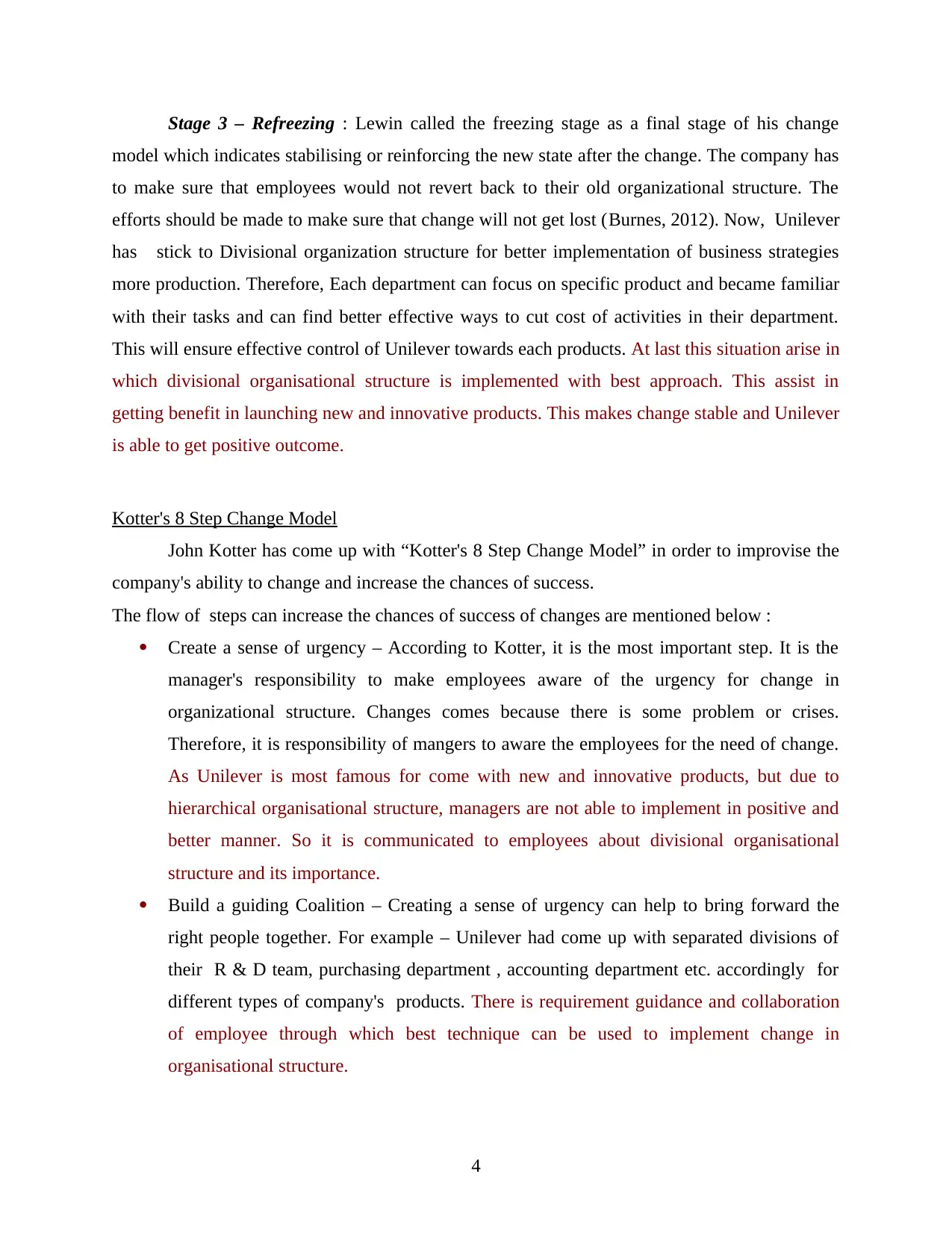
Stage 3 – Refreezing : Lewin called the freezing stage as a final stage of his change
model which indicates stabilising or reinforcing the new state after the change. The company has
to make sure that employees would not revert back to their old organizational structure. The
efforts should be made to make sure that change will not get lost (Burnes, 2012). Now, Unilever
has stick to Divisional organization structure for better implementation of business strategies
more production. Therefore, Each department can focus on specific product and became familiar
with their tasks and can find better effective ways to cut cost of activities in their department.
This will ensure effective control of Unilever towards each products. At last this situation arise in
which divisional organisational structure is implemented with best approach. This assist in
getting benefit in launching new and innovative products. This makes change stable and Unilever
is able to get positive outcome.
Kotter's 8 Step Change Model
John Kotter has come up with “Kotter's 8 Step Change Model” in order to improvise the
company's ability to change and increase the chances of success.
The flow of steps can increase the chances of success of changes are mentioned below :
Create a sense of urgency – According to Kotter, it is the most important step. It is the
manager's responsibility to make employees aware of the urgency for change in
organizational structure. Changes comes because there is some problem or crises.
Therefore, it is responsibility of mangers to aware the employees for the need of change.
As Unilever is most famous for come with new and innovative products, but due to
hierarchical organisational structure, managers are not able to implement in positive and
better manner. So it is communicated to employees about divisional organisational
structure and its importance.
Build a guiding Coalition – Creating a sense of urgency can help to bring forward the
right people together. For example – Unilever had come up with separated divisions of
their R & D team, purchasing department , accounting department etc. accordingly for
different types of company's products. There is requirement guidance and collaboration
of employee through which best technique can be used to implement change in
organisational structure.
4
model which indicates stabilising or reinforcing the new state after the change. The company has
to make sure that employees would not revert back to their old organizational structure. The
efforts should be made to make sure that change will not get lost (Burnes, 2012). Now, Unilever
has stick to Divisional organization structure for better implementation of business strategies
more production. Therefore, Each department can focus on specific product and became familiar
with their tasks and can find better effective ways to cut cost of activities in their department.
This will ensure effective control of Unilever towards each products. At last this situation arise in
which divisional organisational structure is implemented with best approach. This assist in
getting benefit in launching new and innovative products. This makes change stable and Unilever
is able to get positive outcome.
Kotter's 8 Step Change Model
John Kotter has come up with “Kotter's 8 Step Change Model” in order to improvise the
company's ability to change and increase the chances of success.
The flow of steps can increase the chances of success of changes are mentioned below :
Create a sense of urgency – According to Kotter, it is the most important step. It is the
manager's responsibility to make employees aware of the urgency for change in
organizational structure. Changes comes because there is some problem or crises.
Therefore, it is responsibility of mangers to aware the employees for the need of change.
As Unilever is most famous for come with new and innovative products, but due to
hierarchical organisational structure, managers are not able to implement in positive and
better manner. So it is communicated to employees about divisional organisational
structure and its importance.
Build a guiding Coalition – Creating a sense of urgency can help to bring forward the
right people together. For example – Unilever had come up with separated divisions of
their R & D team, purchasing department , accounting department etc. accordingly for
different types of company's products. There is requirement guidance and collaboration
of employee through which best technique can be used to implement change in
organisational structure.
4
⊘ This is a preview!⊘
Do you want full access?
Subscribe today to unlock all pages.

Trusted by 1+ million students worldwide
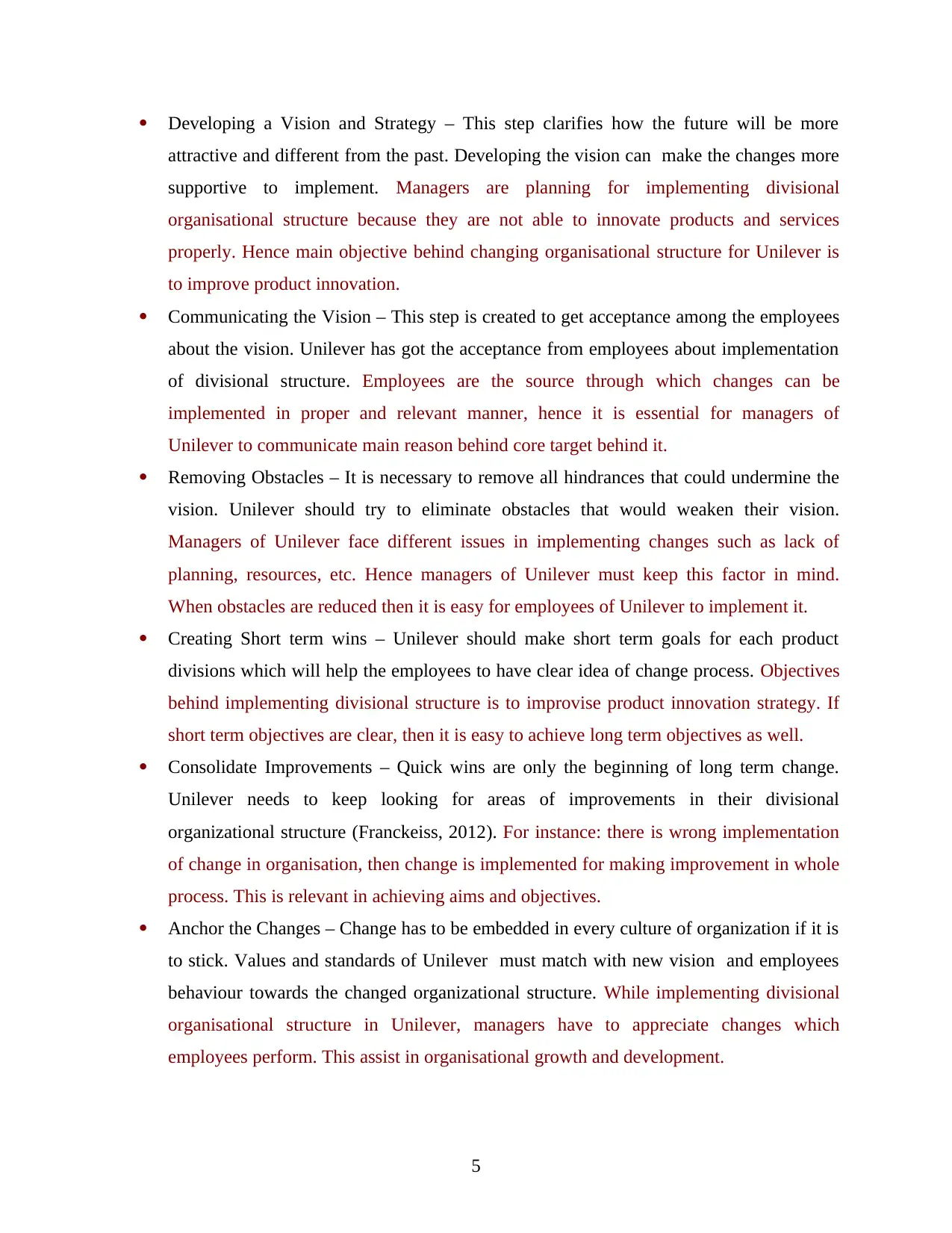
Developing a Vision and Strategy – This step clarifies how the future will be more
attractive and different from the past. Developing the vision can make the changes more
supportive to implement. Managers are planning for implementing divisional
organisational structure because they are not able to innovate products and services
properly. Hence main objective behind changing organisational structure for Unilever is
to improve product innovation.
Communicating the Vision – This step is created to get acceptance among the employees
about the vision. Unilever has got the acceptance from employees about implementation
of divisional structure. Employees are the source through which changes can be
implemented in proper and relevant manner, hence it is essential for managers of
Unilever to communicate main reason behind core target behind it.
Removing Obstacles – It is necessary to remove all hindrances that could undermine the
vision. Unilever should try to eliminate obstacles that would weaken their vision.
Managers of Unilever face different issues in implementing changes such as lack of
planning, resources, etc. Hence managers of Unilever must keep this factor in mind.
When obstacles are reduced then it is easy for employees of Unilever to implement it.
Creating Short term wins – Unilever should make short term goals for each product
divisions which will help the employees to have clear idea of change process. Objectives
behind implementing divisional structure is to improvise product innovation strategy. If
short term objectives are clear, then it is easy to achieve long term objectives as well.
Consolidate Improvements – Quick wins are only the beginning of long term change.
Unilever needs to keep looking for areas of improvements in their divisional
organizational structure (Franckeiss, 2012). For instance: there is wrong implementation
of change in organisation, then change is implemented for making improvement in whole
process. This is relevant in achieving aims and objectives.
Anchor the Changes – Change has to be embedded in every culture of organization if it is
to stick. Values and standards of Unilever must match with new vision and employees
behaviour towards the changed organizational structure. While implementing divisional
organisational structure in Unilever, managers have to appreciate changes which
employees perform. This assist in organisational growth and development.
5
attractive and different from the past. Developing the vision can make the changes more
supportive to implement. Managers are planning for implementing divisional
organisational structure because they are not able to innovate products and services
properly. Hence main objective behind changing organisational structure for Unilever is
to improve product innovation.
Communicating the Vision – This step is created to get acceptance among the employees
about the vision. Unilever has got the acceptance from employees about implementation
of divisional structure. Employees are the source through which changes can be
implemented in proper and relevant manner, hence it is essential for managers of
Unilever to communicate main reason behind core target behind it.
Removing Obstacles – It is necessary to remove all hindrances that could undermine the
vision. Unilever should try to eliminate obstacles that would weaken their vision.
Managers of Unilever face different issues in implementing changes such as lack of
planning, resources, etc. Hence managers of Unilever must keep this factor in mind.
When obstacles are reduced then it is easy for employees of Unilever to implement it.
Creating Short term wins – Unilever should make short term goals for each product
divisions which will help the employees to have clear idea of change process. Objectives
behind implementing divisional structure is to improvise product innovation strategy. If
short term objectives are clear, then it is easy to achieve long term objectives as well.
Consolidate Improvements – Quick wins are only the beginning of long term change.
Unilever needs to keep looking for areas of improvements in their divisional
organizational structure (Franckeiss, 2012). For instance: there is wrong implementation
of change in organisation, then change is implemented for making improvement in whole
process. This is relevant in achieving aims and objectives.
Anchor the Changes – Change has to be embedded in every culture of organization if it is
to stick. Values and standards of Unilever must match with new vision and employees
behaviour towards the changed organizational structure. While implementing divisional
organisational structure in Unilever, managers have to appreciate changes which
employees perform. This assist in organisational growth and development.
5
Paraphrase This Document
Need a fresh take? Get an instant paraphrase of this document with our AI Paraphraser

The driving forces of change-
The organisation generally faces two types of forces of changes. They are internal and
external forces. Internal change consists of change in strategy, policies, management and
structure whereas external change consists of change in legislation, competition, politics and
economics. The effect of change can be seen on every business, organisation, industry, etc. To
attain success every organisation should be able to take advantage of the driving forces of
change. The driving forces of changes in Unilever were internal – strategy and structure. The
positive and negative driving forces of change in Unilever are given as under:-
Positive driving force- Product development and innovation. For example, each division
of the product type has its specific capabilities to develop products that are needed in the market
by the customers. It helps Unilever to distinguish its products despite of large size of the
operational area. With implementation of divisional organisational structure, it is easy to plan
innovations in products offered by Unilever. There is requirement of proper planning through
which it is easy to understand policies which are specific and relevant in organisational growth
and development.
Negative driving force- Regional strategic implementation is less adopted. The focus of
the company is more on product type divisions and hence, there is restricted support for regional
strategic reforms or market-specific. Employees have idea to work in hierarchy manner, so there
is proper communication and approval for any change. But in divisional organisational structure,
team mates have to give best and make strategies to implement change. Hence there are
possibilities that different divisions perform similar activities due to which there are possibilities
of wastage of resources.
Resistance to change-
Control of the employees- The managerial control of the employees can be increased by
Organizational change and hence, can make employees resistant to such proposal of change. The
division of the organisation's structure into 3 divisions Beauty and personal care, foods and
refreshment, home care will lead to more increase in supervision and hence, in the power of
managers.
Economic reasons:-. Organizational changes can be done due to availability of economic
privileges. It may lead to increment or decrement of salary of employees. The employees who
will not be benefited from this change will resist to change. The increase in employment
6
The organisation generally faces two types of forces of changes. They are internal and
external forces. Internal change consists of change in strategy, policies, management and
structure whereas external change consists of change in legislation, competition, politics and
economics. The effect of change can be seen on every business, organisation, industry, etc. To
attain success every organisation should be able to take advantage of the driving forces of
change. The driving forces of changes in Unilever were internal – strategy and structure. The
positive and negative driving forces of change in Unilever are given as under:-
Positive driving force- Product development and innovation. For example, each division
of the product type has its specific capabilities to develop products that are needed in the market
by the customers. It helps Unilever to distinguish its products despite of large size of the
operational area. With implementation of divisional organisational structure, it is easy to plan
innovations in products offered by Unilever. There is requirement of proper planning through
which it is easy to understand policies which are specific and relevant in organisational growth
and development.
Negative driving force- Regional strategic implementation is less adopted. The focus of
the company is more on product type divisions and hence, there is restricted support for regional
strategic reforms or market-specific. Employees have idea to work in hierarchy manner, so there
is proper communication and approval for any change. But in divisional organisational structure,
team mates have to give best and make strategies to implement change. Hence there are
possibilities that different divisions perform similar activities due to which there are possibilities
of wastage of resources.
Resistance to change-
Control of the employees- The managerial control of the employees can be increased by
Organizational change and hence, can make employees resistant to such proposal of change. The
division of the organisation's structure into 3 divisions Beauty and personal care, foods and
refreshment, home care will lead to more increase in supervision and hence, in the power of
managers.
Economic reasons:-. Organizational changes can be done due to availability of economic
privileges. It may lead to increment or decrement of salary of employees. The employees who
will not be benefited from this change will resist to change. The increase in employment
6
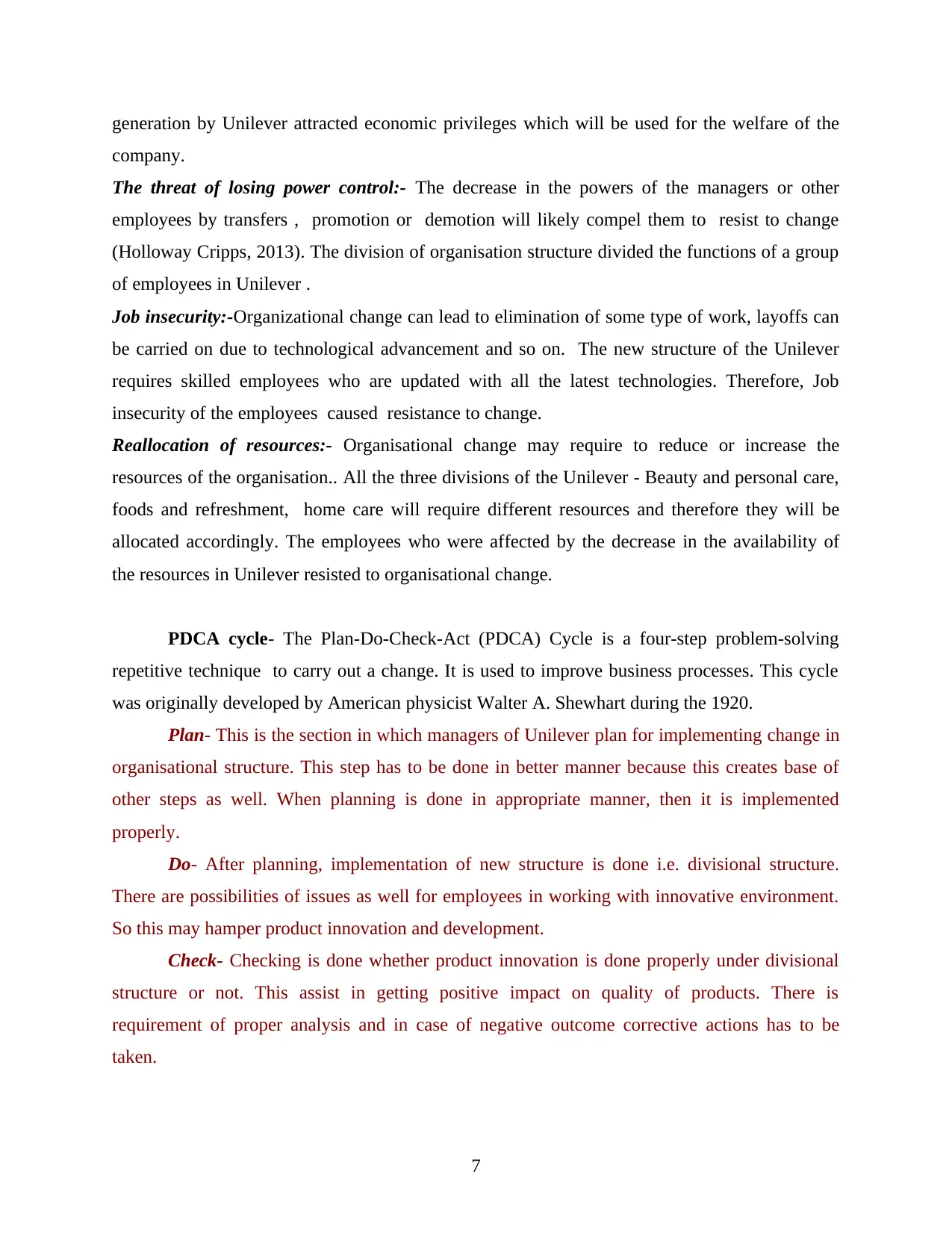
generation by Unilever attracted economic privileges which will be used for the welfare of the
company.
The threat of losing power control:- The decrease in the powers of the managers or other
employees by transfers , promotion or demotion will likely compel them to resist to change
(Holloway Cripps, 2013). The division of organisation structure divided the functions of a group
of employees in Unilever .
Job insecurity:-Organizational change can lead to elimination of some type of work, layoffs can
be carried on due to technological advancement and so on. The new structure of the Unilever
requires skilled employees who are updated with all the latest technologies. Therefore, Job
insecurity of the employees caused resistance to change.
Reallocation of resources:- Organisational change may require to reduce or increase the
resources of the organisation.. All the three divisions of the Unilever - Beauty and personal care,
foods and refreshment, home care will require different resources and therefore they will be
allocated accordingly. The employees who were affected by the decrease in the availability of
the resources in Unilever resisted to organisational change.
PDCA cycle- The Plan-Do-Check-Act (PDCA) Cycle is a four-step problem-solving
repetitive technique to carry out a change. It is used to improve business processes. This cycle
was originally developed by American physicist Walter A. Shewhart during the 1920.
Plan- This is the section in which managers of Unilever plan for implementing change in
organisational structure. This step has to be done in better manner because this creates base of
other steps as well. When planning is done in appropriate manner, then it is implemented
properly.
Do- After planning, implementation of new structure is done i.e. divisional structure.
There are possibilities of issues as well for employees in working with innovative environment.
So this may hamper product innovation and development.
Check- Checking is done whether product innovation is done properly under divisional
structure or not. This assist in getting positive impact on quality of products. There is
requirement of proper analysis and in case of negative outcome corrective actions has to be
taken.
7
company.
The threat of losing power control:- The decrease in the powers of the managers or other
employees by transfers , promotion or demotion will likely compel them to resist to change
(Holloway Cripps, 2013). The division of organisation structure divided the functions of a group
of employees in Unilever .
Job insecurity:-Organizational change can lead to elimination of some type of work, layoffs can
be carried on due to technological advancement and so on. The new structure of the Unilever
requires skilled employees who are updated with all the latest technologies. Therefore, Job
insecurity of the employees caused resistance to change.
Reallocation of resources:- Organisational change may require to reduce or increase the
resources of the organisation.. All the three divisions of the Unilever - Beauty and personal care,
foods and refreshment, home care will require different resources and therefore they will be
allocated accordingly. The employees who were affected by the decrease in the availability of
the resources in Unilever resisted to organisational change.
PDCA cycle- The Plan-Do-Check-Act (PDCA) Cycle is a four-step problem-solving
repetitive technique to carry out a change. It is used to improve business processes. This cycle
was originally developed by American physicist Walter A. Shewhart during the 1920.
Plan- This is the section in which managers of Unilever plan for implementing change in
organisational structure. This step has to be done in better manner because this creates base of
other steps as well. When planning is done in appropriate manner, then it is implemented
properly.
Do- After planning, implementation of new structure is done i.e. divisional structure.
There are possibilities of issues as well for employees in working with innovative environment.
So this may hamper product innovation and development.
Check- Checking is done whether product innovation is done properly under divisional
structure or not. This assist in getting positive impact on quality of products. There is
requirement of proper analysis and in case of negative outcome corrective actions has to be
taken.
7
⊘ This is a preview!⊘
Do you want full access?
Subscribe today to unlock all pages.

Trusted by 1+ million students worldwide
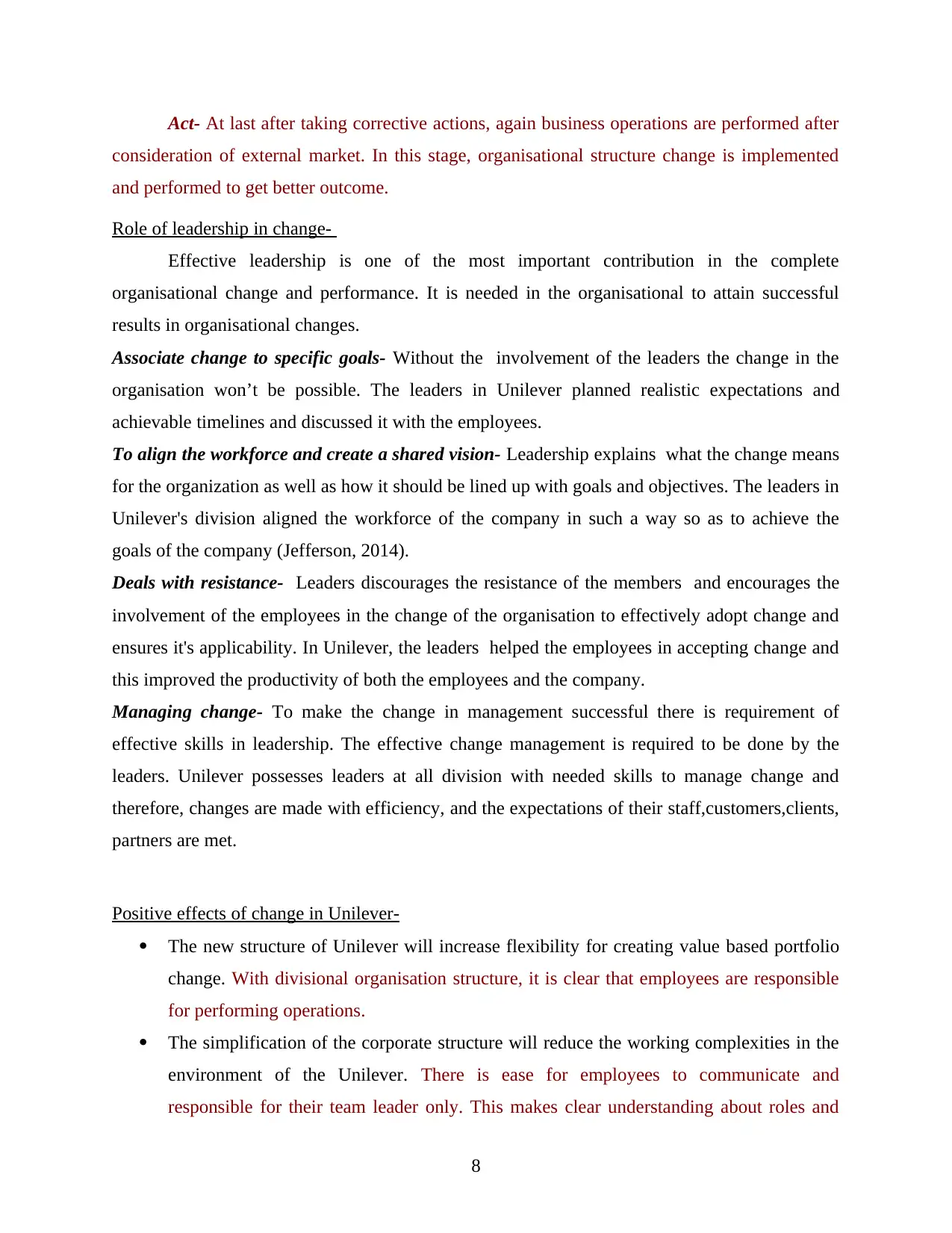
Act- At last after taking corrective actions, again business operations are performed after
consideration of external market. In this stage, organisational structure change is implemented
and performed to get better outcome.
Role of leadership in change-
Effective leadership is one of the most important contribution in the complete
organisational change and performance. It is needed in the organisational to attain successful
results in organisational changes.
Associate change to specific goals- Without the involvement of the leaders the change in the
organisation won’t be possible. The leaders in Unilever planned realistic expectations and
achievable timelines and discussed it with the employees.
To align the workforce and create a shared vision- Leadership explains what the change means
for the organization as well as how it should be lined up with goals and objectives. The leaders in
Unilever's division aligned the workforce of the company in such a way so as to achieve the
goals of the company (Jefferson, 2014).
Deals with resistance- Leaders discourages the resistance of the members and encourages the
involvement of the employees in the change of the organisation to effectively adopt change and
ensures it's applicability. In Unilever, the leaders helped the employees in accepting change and
this improved the productivity of both the employees and the company.
Managing change- To make the change in management successful there is requirement of
effective skills in leadership. The effective change management is required to be done by the
leaders. Unilever possesses leaders at all division with needed skills to manage change and
therefore, changes are made with efficiency, and the expectations of their staff,customers,clients,
partners are met.
Positive effects of change in Unilever-
The new structure of Unilever will increase flexibility for creating value based portfolio
change. With divisional organisation structure, it is clear that employees are responsible
for performing operations.
The simplification of the corporate structure will reduce the working complexities in the
environment of the Unilever. There is ease for employees to communicate and
responsible for their team leader only. This makes clear understanding about roles and
8
consideration of external market. In this stage, organisational structure change is implemented
and performed to get better outcome.
Role of leadership in change-
Effective leadership is one of the most important contribution in the complete
organisational change and performance. It is needed in the organisational to attain successful
results in organisational changes.
Associate change to specific goals- Without the involvement of the leaders the change in the
organisation won’t be possible. The leaders in Unilever planned realistic expectations and
achievable timelines and discussed it with the employees.
To align the workforce and create a shared vision- Leadership explains what the change means
for the organization as well as how it should be lined up with goals and objectives. The leaders in
Unilever's division aligned the workforce of the company in such a way so as to achieve the
goals of the company (Jefferson, 2014).
Deals with resistance- Leaders discourages the resistance of the members and encourages the
involvement of the employees in the change of the organisation to effectively adopt change and
ensures it's applicability. In Unilever, the leaders helped the employees in accepting change and
this improved the productivity of both the employees and the company.
Managing change- To make the change in management successful there is requirement of
effective skills in leadership. The effective change management is required to be done by the
leaders. Unilever possesses leaders at all division with needed skills to manage change and
therefore, changes are made with efficiency, and the expectations of their staff,customers,clients,
partners are met.
Positive effects of change in Unilever-
The new structure of Unilever will increase flexibility for creating value based portfolio
change. With divisional organisation structure, it is clear that employees are responsible
for performing operations.
The simplification of the corporate structure will reduce the working complexities in the
environment of the Unilever. There is ease for employees to communicate and
responsible for their team leader only. This makes clear understanding about roles and
8
Paraphrase This Document
Need a fresh take? Get an instant paraphrase of this document with our AI Paraphraser
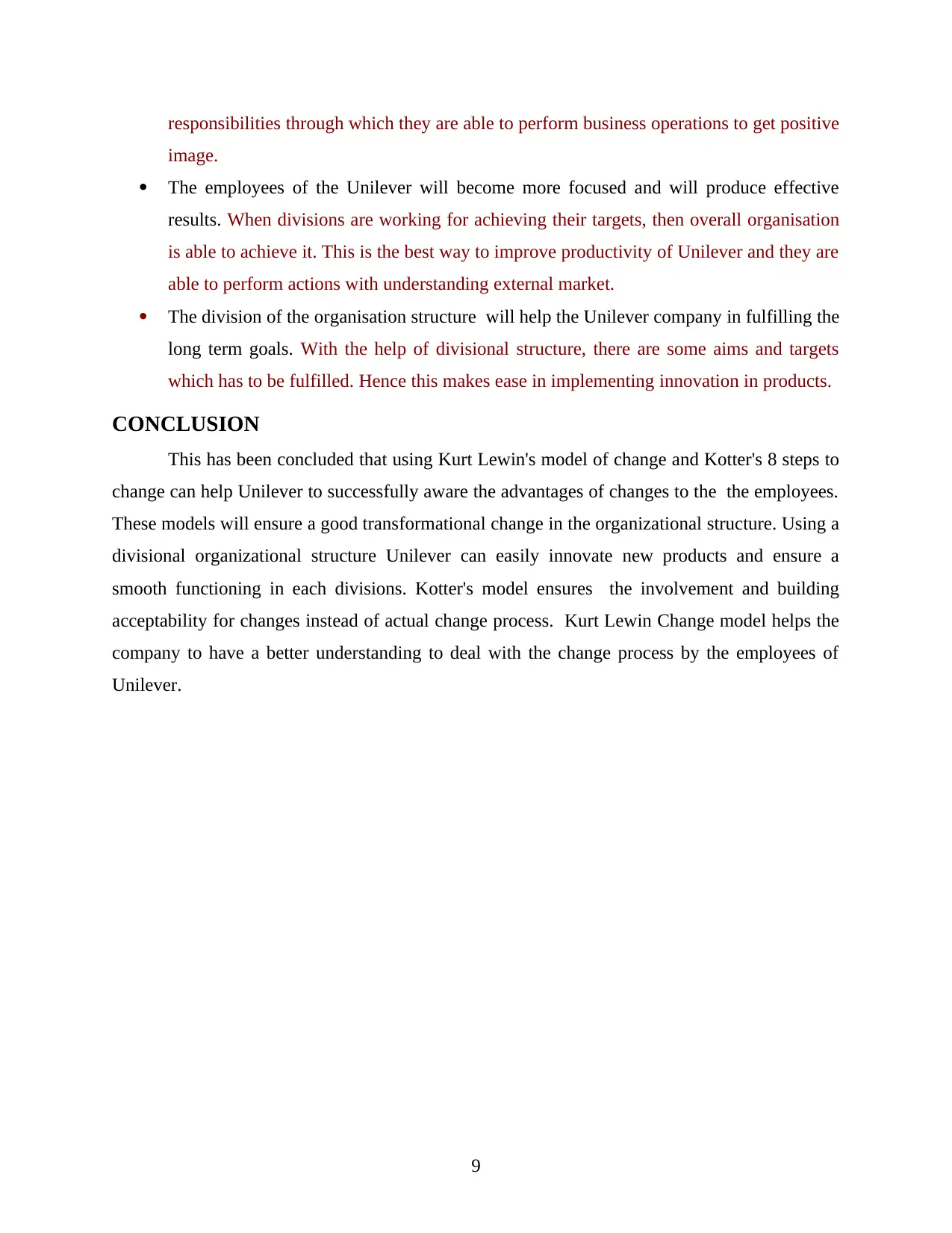
responsibilities through which they are able to perform business operations to get positive
image.
The employees of the Unilever will become more focused and will produce effective
results. When divisions are working for achieving their targets, then overall organisation
is able to achieve it. This is the best way to improve productivity of Unilever and they are
able to perform actions with understanding external market.
The division of the organisation structure will help the Unilever company in fulfilling the
long term goals. With the help of divisional structure, there are some aims and targets
which has to be fulfilled. Hence this makes ease in implementing innovation in products.
CONCLUSION
This has been concluded that using Kurt Lewin's model of change and Kotter's 8 steps to
change can help Unilever to successfully aware the advantages of changes to the the employees.
These models will ensure a good transformational change in the organizational structure. Using a
divisional organizational structure Unilever can easily innovate new products and ensure a
smooth functioning in each divisions. Kotter's model ensures the involvement and building
acceptability for changes instead of actual change process. Kurt Lewin Change model helps the
company to have a better understanding to deal with the change process by the employees of
Unilever.
9
image.
The employees of the Unilever will become more focused and will produce effective
results. When divisions are working for achieving their targets, then overall organisation
is able to achieve it. This is the best way to improve productivity of Unilever and they are
able to perform actions with understanding external market.
The division of the organisation structure will help the Unilever company in fulfilling the
long term goals. With the help of divisional structure, there are some aims and targets
which has to be fulfilled. Hence this makes ease in implementing innovation in products.
CONCLUSION
This has been concluded that using Kurt Lewin's model of change and Kotter's 8 steps to
change can help Unilever to successfully aware the advantages of changes to the the employees.
These models will ensure a good transformational change in the organizational structure. Using a
divisional organizational structure Unilever can easily innovate new products and ensure a
smooth functioning in each divisions. Kotter's model ensures the involvement and building
acceptability for changes instead of actual change process. Kurt Lewin Change model helps the
company to have a better understanding to deal with the change process by the employees of
Unilever.
9
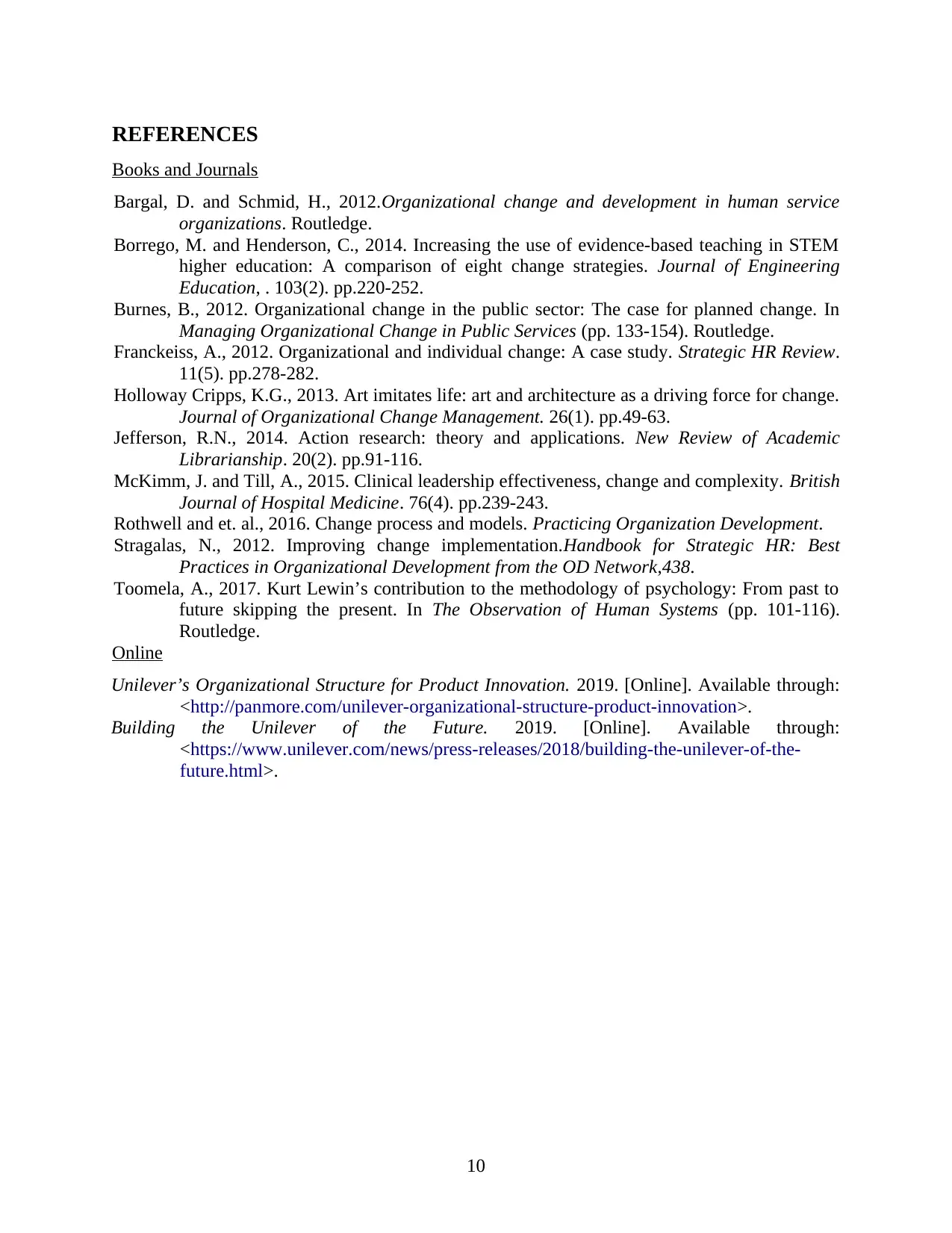
REFERENCES
Books and Journals
Bargal, D. and Schmid, H., 2012.Organizational change and development in human service
organizations. Routledge.
Borrego, M. and Henderson, C., 2014. Increasing the use of evidence‐based teaching in STEM
higher education: A comparison of eight change strategies. Journal of Engineering
Education, . 103(2). pp.220-252.
Burnes, B., 2012. Organizational change in the public sector: The case for planned change. In
Managing Organizational Change in Public Services (pp. 133-154). Routledge.
Franckeiss, A., 2012. Organizational and individual change: A case study. Strategic HR Review.
11(5). pp.278-282.
Holloway Cripps, K.G., 2013. Art imitates life: art and architecture as a driving force for change.
Journal of Organizational Change Management. 26(1). pp.49-63.
Jefferson, R.N., 2014. Action research: theory and applications. New Review of Academic
Librarianship. 20(2). pp.91-116.
McKimm, J. and Till, A., 2015. Clinical leadership effectiveness, change and complexity. British
Journal of Hospital Medicine. 76(4). pp.239-243.
Rothwell and et. al., 2016. Change process and models. Practicing Organization Development.
Stragalas, N., 2012. Improving change implementation.Handbook for Strategic HR: Best
Practices in Organizational Development from the OD Network,438.
Toomela, A., 2017. Kurt Lewin’s contribution to the methodology of psychology: From past to
future skipping the present. In The Observation of Human Systems (pp. 101-116).
Routledge.
Online
Unilever’s Organizational Structure for Product Innovation. 2019. [Online]. Available through:
<http://panmore.com/unilever-organizational-structure-product-innovation>.
Building the Unilever of the Future. 2019. [Online]. Available through:
<https://www.unilever.com/news/press-releases/2018/building-the-unilever-of-the-
future.html>.
10
Books and Journals
Bargal, D. and Schmid, H., 2012.Organizational change and development in human service
organizations. Routledge.
Borrego, M. and Henderson, C., 2014. Increasing the use of evidence‐based teaching in STEM
higher education: A comparison of eight change strategies. Journal of Engineering
Education, . 103(2). pp.220-252.
Burnes, B., 2012. Organizational change in the public sector: The case for planned change. In
Managing Organizational Change in Public Services (pp. 133-154). Routledge.
Franckeiss, A., 2012. Organizational and individual change: A case study. Strategic HR Review.
11(5). pp.278-282.
Holloway Cripps, K.G., 2013. Art imitates life: art and architecture as a driving force for change.
Journal of Organizational Change Management. 26(1). pp.49-63.
Jefferson, R.N., 2014. Action research: theory and applications. New Review of Academic
Librarianship. 20(2). pp.91-116.
McKimm, J. and Till, A., 2015. Clinical leadership effectiveness, change and complexity. British
Journal of Hospital Medicine. 76(4). pp.239-243.
Rothwell and et. al., 2016. Change process and models. Practicing Organization Development.
Stragalas, N., 2012. Improving change implementation.Handbook for Strategic HR: Best
Practices in Organizational Development from the OD Network,438.
Toomela, A., 2017. Kurt Lewin’s contribution to the methodology of psychology: From past to
future skipping the present. In The Observation of Human Systems (pp. 101-116).
Routledge.
Online
Unilever’s Organizational Structure for Product Innovation. 2019. [Online]. Available through:
<http://panmore.com/unilever-organizational-structure-product-innovation>.
Building the Unilever of the Future. 2019. [Online]. Available through:
<https://www.unilever.com/news/press-releases/2018/building-the-unilever-of-the-
future.html>.
10
⊘ This is a preview!⊘
Do you want full access?
Subscribe today to unlock all pages.

Trusted by 1+ million students worldwide
1 out of 12
Related Documents
Your All-in-One AI-Powered Toolkit for Academic Success.
+13062052269
info@desklib.com
Available 24*7 on WhatsApp / Email
![[object Object]](/_next/static/media/star-bottom.7253800d.svg)
Unlock your academic potential
Copyright © 2020–2025 A2Z Services. All Rights Reserved. Developed and managed by ZUCOL.





